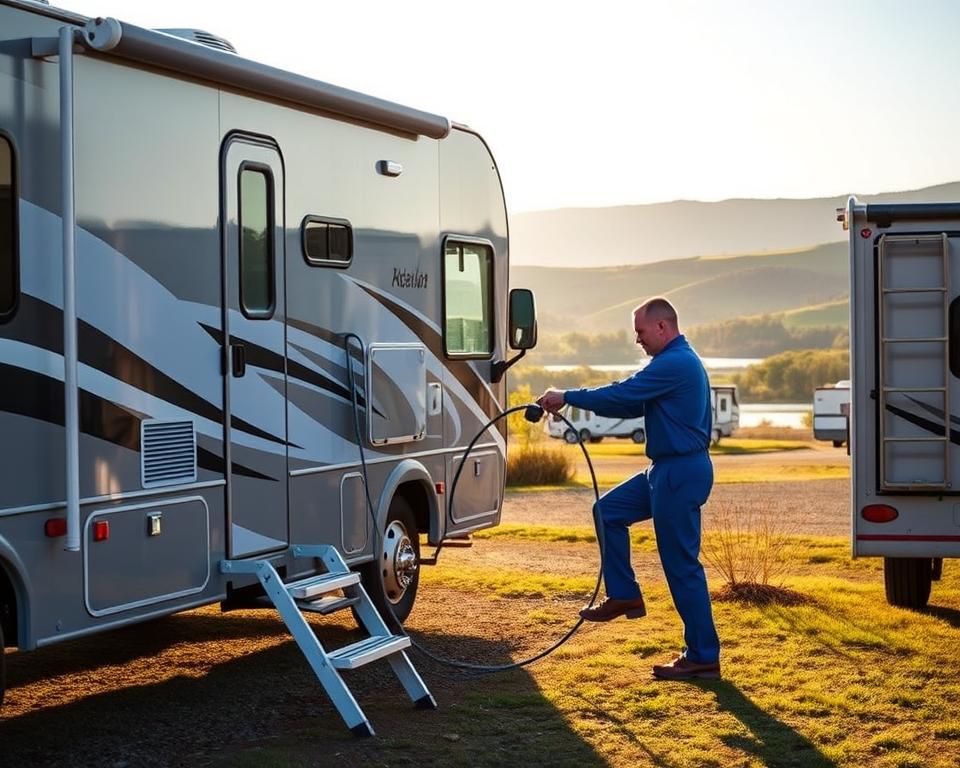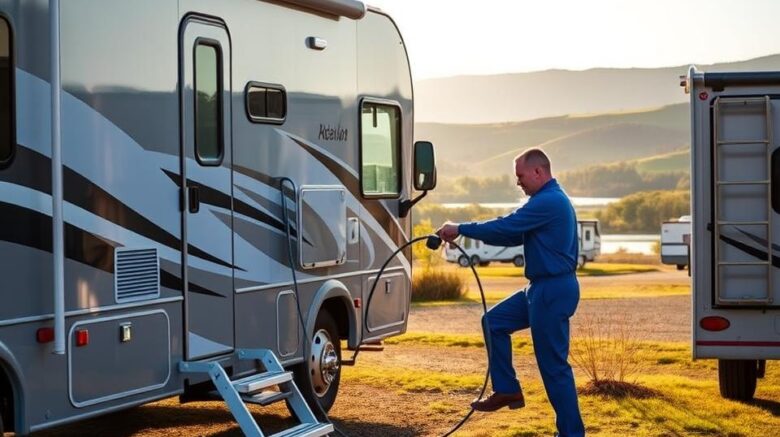RV Waste Tank Pumping: Vital Maintenance Advice
Consider the consequences of neglecting your RV’s septic system. Many RV owners find the idea of septic tank pumping daunting. However, recognizing the need for regular servicing is crucial. These steps preserve your camping joy and avoid expensive repairs. Mastering correct waste handling is fundamental to your system’s longevity. We’ll share vital insights on RV sewer pump, including best practices and tips to keep your system running smoothly.
Understanding Your RV Septic System
Every recreational vehicle features a septic setup. It consists of a black tank for toilet use, a gray tank for sinks/showers, plus a freshwater reservoir. Knowing these components prevents clogs and ensures efficient cleaning.
Drains and vents manage liquid and air movement throughout the system. Understanding this synergy helps you avoid blockages and buildup. It’s the foundation of a smooth camping experience.
Regular checks and care keep your tanks in top shape. Frequently checking tank levels and emptying on time preserves comfort. By maintaining your RV’s septic system properly, you’ll improve its lifespan and enjoy every trip more.
Importance of Regular RV Septic Tank Pumping
Frequent tank pumping keeps your system working and clean. Leftover solids lead to smells and clogs, spoiling your trip. A full tank can produce embarrassing backups. Such mishaps kill the fun on the road.
Skipping pump-outs leads to pricey repairs. System failures cause leaks and wear out parts prematurely. Timely emptying keeps your plumbing running smoothly. You’ll avoid nasty surprises and costly breakdowns.
Proactive servicing stops clogs. Investing in pump-outs shows you care about your RV. Your trips become more relaxing. By sticking to a dump schedule, you’ll relish the outdoors worry-free.
How Often Should You Pump Your RV Septic Tank?
Timing your tank dumps depends on several variables. Generally, dump every 3–5 days when in use. Still, it varies with tank size and occupancy. Knowing when to pump is vital for managing RV wastewater.
Dump the black tank at about two-thirds capacity. This prevents solids from clogging and keeps flow steady. Ignoring it can cause backups and unpleasant odors.
Many elements can affect how often you pump:
- Number of people on board
- Length of stay
- Type of waste generated
- Tank capacity
Planning is key to avoiding emergencies. Remember portable toilet service schedules. Tracking your usage helps forecast dump needs.
| Usage Scenario | Pumping Frequency |
|---|---|
| Short Trip, Two Campers | Every 3–4 days |
| Long Stay, Four to Six Occupants | Every 2–3 days |
| Seasonal Living (2–4 people) | Weekly or Bi-Weekly |
Monitor fill levels and usage patterns. Staying attentive guarantees a pleasant trip.

Proper Tank Dumping Techniques
Correct dumping preserves system health and prevents issues. Always empty the black tank first to protect the gray tank. This prevents dirty water from fouling the clean.
Using a high-quality hose minimizes leaks and ensures smooth dumping. Tighten connections to stop spills. Once both tanks are clear, rinse the black tank thoroughly. This removes residue and preps the tank for next time.
Know where dump stations are located. Being prepared saves time on the road.
To summarize, use these steps:
- Empty the black water tank first.
- Use a top-quality sewer hose.
- Flush the black tank thoroughly after emptying.
- Plan your dump station locations.
Following these guidelines simplifies black tank maintenance.
Proper Use and Maintenance of Your RV Tanks
Grasping correct handling of black and gray tanks ensures system health. Keep some water in the black tank for better breakdown.
Refrain from disposing non-biodegradable items. Use only RV-compatible paper. Regular checks spot leaks or cracks before they worsen.
Adding treatments now and then improves septic service. They introduce microbes that digest solids effectively. Such measures keep your tanks operating at their best.
- Check for leaks and damage often.
- Apply RV-specific chemical treatments.
- Keep vents clear to avoid odors.
Following these rules protects your septic setup. It also boosts your camping enjoyment.
How to Pump Efficiently
To pump your tank effectively, follow a methodical approach. Proper disposal prevents issues—only dump at approved stations. Understanding volume limits prevents spills on the go.
Check tank indicators regularly to time pump-outs. Routine scheduling preserves your septic system and travel enjoyment. A planned maintenance routine keeps everything running smoothly.
Flush well after every emptying. This clears residue for more efficient future pump-outs. Such tactics keep your rig in top shape and improve your travel experiences.
Typical RV Septic Pitfalls
Upkeep prevents trip interruptions. Insufficient flushing causes solids to accumulate. Adequate water use breaks down solids efficiently.
Wrong flushables cause havoc—never flush wipes or towels. Avoid non-dissolvable products like feminine hygiene items. Such mistakes can damage plumbing and inflate repair bills.
Leaving the black valve open too early is a mistake. Premature opening prevents a full flush. Only open when ready to empty for a complete clean.
Knowing these pitfalls helps maintain efficiency. Avoiding them keeps your waste management reliable.
Signs You Need Expert Help
Recognizing the need for expert help extends tank life. Lingering smells can mean serious tank problems. Slow drains point to potential clogs or buildup.
Visible residue at dump points requires attention. Such situations usually need high-pressure cleaning. Pros blast away blockages to restore smooth flow.
Regular expert check-ups safeguard tank health. Early intervention avoids expensive failures. Professional service ensures proper functionality.
Long-Term Maintenance for Your RV Wastewater Management
Smart upkeep ensures lasting system performance. Regular pumping boosts system life and function. Routine rinses clear residue and stave off expensive breakdowns.
Implementing clean cycles safeguards tank health. Checking seals and joints avoids leaks. Opting for biodegradable products protects plumbing.
Consider these long-term practices:
- Stick to a pump-out timetable.
- Rinse often to remove solids.
- Sanitize twice a year.
- Inspect parts frequently for wear and tear.
Investing in prevention brings peace of mind. Routine service lets you focus on the scenery, not your sewer.
To Summarize
Good septic care ensures enjoyable trips. Understanding operation and following guidelines prevents headaches. Routine black tank dumping boosts performance. This makes your journey more comfortable.
By regularly checking and properly caring for your septic setup, you’ll ensure worry-free travel. This reliability supports every outing. Adopting these habits keeps your RV ready to roll. Thus, you can concentrate on adventures rather than septic concerns.
